Types of Hairy Caterpillars (With Pictures) – Identification Guide
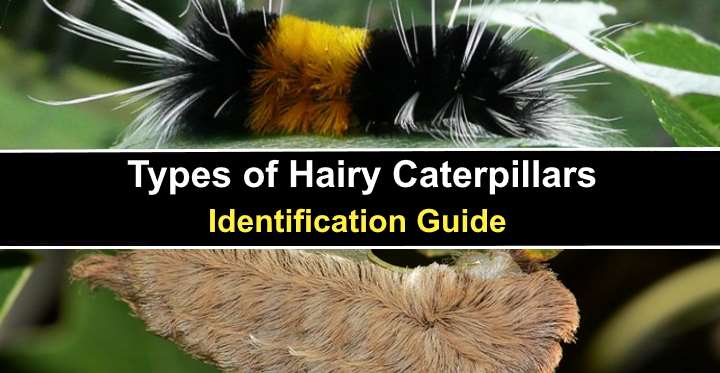
Hairy caterpillars may look cute and fluffy, but many species of these furry worm-like creatures have stinging spines. Species of caterpillars covered in hairs come in all shapes and sizes. For example, there are fuzzy white caterpillars with long pencil setae. Other hairy caterpillars may be covered in tufts of dense hairs giving the worms a furry appearance. Different types of hairy caterpillars may look like black and brown woolly tubes.
Not all hairy caterpillars are venomous and cause skin irritation when you handle them. Therefore, identifying caterpillars that look hairy is vital to avoid picking up a stinging caterpillar. Generally, it’s best to wear protective gloves before handling a hairy caterpillar you’re unsure of.
This article is a guide to identifying common species of hairy caterpillars you may find on shrubs in the yard, woodlands, grasslands, or parks. Descriptions and pictures of the furry worms will help you spot a harmless hairy caterpillar from stinging ones.
Hairy Caterpillar Identification
To identify a hairy-looking caterpillar, it’s necessary to note its color, appearance, type of hairs, the shape of the head, and identifying markings. Most hairy caterpillars have the characteristic form of a slender cylindrical worm. However, some unusual furry caterpillars look like brown squashed spiders or fuzzy leaves.
Identifying types of hairy caterpillars can be challenging due to their life cycle. For example, some caterpillar species change their appearance after every instar (growth stage). Therefore, a butterfly or moth larva that has recently hatched may appear differently from the adult caterpillar just before pupation.
Types of Hairy Caterpillars (With Pictures)
Let’s look in more detail at various types of hairy caterpillars you might find in your garden.
Banded Woolly Bear Caterpillar (Pyrrharctia isabella)
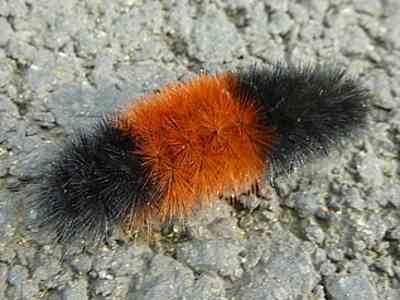
The banded woolly bear caterpillar is a hairy type of caterpillar with black and orange hairs
The banded woolly bear caterpillar is a furry, black and orange caterpillar. The hairy woolly bear caterpillar has a black body with a broad orange colored band around its center. The dense hairs covering the caterpillar make it impossible to see its six legs, small black head, and 13 segments.
Despite its fluffy appearance, the spiny hairs covering the black and orange fuzzy woolly bear caterpillar can prick your skin. Although the spines don’t contain venom, the prickly setae can result in skin irritation and itchiness.
The hairy banded woolly bear turns into the spectacular orange Isabella tiger moth.
Other names for this common hairy caterpillar include woolybear and wooly worm.
Hairy caterpillar identification
The banded woolly bear measures up to 2” (50 mm) and has a recognizable hairy black and orange body. An identifying characteristic of the woolly bear is how it rolls into a ball when it feels threatened.
- Adult Stage: Isabella Tiger Moth
- Host Plants: Various plants, including grasses, clover, low-growing vegetation, and weeds including plantain, dandelion, and nettles
- Habitat and Distribution: Meadows, open fields, gardens, and forests in North America, particularly the United States and Canada
- Stinging: No, they do not have stinging hairs. But the bristles can cause skin irritation but are not poisonous
Sycamore Tussock Moth Caterpillar (Halysidota harrisii)
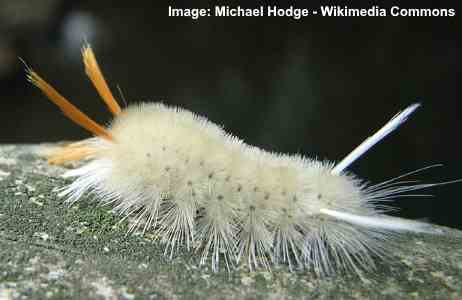
The white furry sycamore tussock caterpillar has an unusual pair of hairs on each end
The sycamore tussock caterpillar is a strange white hairy caterpillar with a pair of distinctive hair pencils protruding from both ends. The caterpillar has a yellow-orange head and body covered in white bristly hairs. Although the white caterpillar won’t sting, its spiny tufts can cause skin irritation if you pick the insect up.
The sycamore tussock moth caterpillar is found on the American sycamore tree and turns into a moth.
Hairy caterpillar identification
The identifying features of the sycamore tussock caterpillar are a hairy white body, two long orange pencil hair tufts at one end, and two at the other. The small hair-covered white caterpillars measure up to 1.1” (30 mm).
- Adult Stage: The adult stage is the sycamore tussock moth.
- Host Plants: The caterpillar feeds on various trees and shrubs, including but not limited to maple, oak, willow, and cherry trees.
- Habitat and Distribution: Halysidota harrisii can be found in woodland areas, parks, gardens, and forests across North America, primarily in the northeastern and central regions, including the United States and Canada.
- Stinging: Potential for skin irritation upon contact, may cause mild irritation in some individuals
Banded Tussock Moth Caterpillar (Halysidota tessellaris)
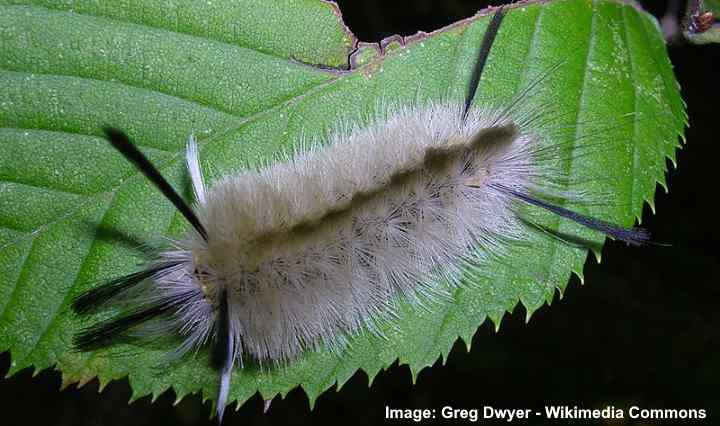
The fluffy banded tussock moth caterpillar is identified by its long black hair tufts at the end of each side
The banded tussock moth caterpillar is a hairy grayish caterpillar. The black and white caterpillar has distinctive tufts of long, black pencil hairs protruding from its ends. The hair-covered worm also has a black stripe along its back and a bright orange head that is difficult to spot under the hairs.
You can find banded tussock moth caterpillars on birch, ash, alder, oak, and willow trees. Despite the caterpillars’ habit of chewing on leaves, they rarely do damage to trees or shrubs.
Hairy caterpillar identification
The distinctive features of the hairy banded tussock moth caterpillar are its six tufts of long black lashes and two shorter white tufts. This hairy caterpillar measures 0.19” (35 mm) long.
- Adult Stage: The adult stage is the Pale Tiger Moth (also called the Pale Tiger Moth)
- Host Plants: The caterpillar primarily feeds on a variety of plants such as elm, oak, willow, and maple trees.
- Habitat and Distribution: Halysidota tessellaris can be found in various habitats including woodlands, forests, parks, and gardens across North America, particularly in the eastern and central regions, including the United States and Canada.
- Stinging: The caterpillar of Halysidota tessellaris is not known to possess stinging hairs or cause significant skin irritation in humans. However, direct contact with the caterpillar may cause mild skin irritation in some individuals.
American Dagger Moth Caterpillar (Acronicta americana)

The American dagger caterpillar can be identified by its distinct yellow-whitish hairy look
The American dagger moth caterpillar is a hairy yellow caterpillar covered in long wispy pale yellow hairs. Notable features of this fuzzy worm include a rounded shiny black head and two pairs of long black tufts on its abdomen. The non-venomous caterpillar’s hairy body can cause skin irritation.
Although not venomous, picking up an American dagger caterpillar can feel like getting stung. The irritating bristly yellow hairs can penetrate the skin and break off.
American dagger moth caterpillars are found on oak, birch, elm, and maple leaves between July and October. After pupating, the caterpillar turns into a gray American dagger moth.
Hairy caterpillar identification
The characteristics of the American dagger caterpillar are its shaggy-looking pale-yellow body and pairs of long black setae on its back.
- Adult Stage: American Dagger Moth
- Host Plants: Various trees including birch, elm, maple, and oak
- Habitat and Distribution: Native to North America, commonly found in forests, woodlands, and urban parks
- Stinging: Contact may result in skin irritation, with some individuals experiencing allergic reactions characterized by itching and redness
Sycamore Moth (Acronicta aceris)
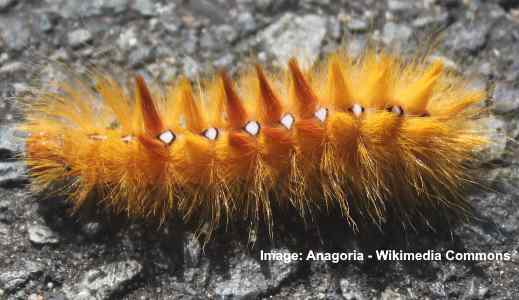
The fuzzy sycamore moth caterpillar has orange-yellow hairs and white dots along its body
The sycamore moth is an easily identifiable hairy yellow caterpillar with bright orange tufts and white spots on its back. The orange-yellow sycamore caterpillar has a black head, six prolegs, and a short body. These non-stinging caterpillars grow up to 1.5” (40 mm) long and are found on sycamore and horse chestnut trees.
Hairy caterpillar identification
The most notable features of the sycamore moth caterpillar are its pyramidal tufts of orangey-yellow hairs and row of white dots along its back.
- Adult Stage: The adult stage is the Sycamore Moth.
- Host Plants: The caterpillar primarily feeds on various deciduous trees, including but not limited to maple, oak, and birch trees.
- Habitat and Distribution: Acronicta aceris can be found in various habitats such as forests, woodlands, and urban areas across Europe, particularly in countries like the United Kingdom, Germany, France, and others.
- Stinging: The caterpillar of Acronicta aceris is not known to possess stinging hairs or cause significant skin irritation in humans. However, direct contact with the caterpillar may cause mild skin irritation in some individuals.
Milkweed Tiger Moth Caterpillar (Euchaetes egle)

The small milkweed tiger moth caterpillar has white, black and orange hairy tufts
The milkweed tiger moth caterpillar is a distinctive hairy worm-like insect caterpillar due to the black, white, and orange furry tufts covering its body. Also called the milkweed tussock moth, the hairy insect takes on a more orangey appearance as it matures. The hairy leaf-feeding creatures measure up to 1.3” (35 mm).
The black and orange hairy caterpillars can do tremendous damage to milkweed and dogbane plants as they skeletonize leaves. In addition, the hairy caterpillars become poisonous to birds and predators due to the chemicals in milkweed sap they consume.
Hairy caterpillar identification
The distinguishing features of the milkweed tiger moth caterpillar are the black, orange, and white tufts covering its body.
- Adult Stage: Milkweed Tiger Moth
- Host Plants: Primarily feeds on milkweed plants
- Habitat and Distribution: Found in North and Central America, particularly in open fields, meadows, and areas with abundant milkweed
- Stinging: Displays warning colors but does not typically sting or cause significant skin irritation in humans
White-Marked Tussock Moth Caterpillar (Orgyia leucostigma)

The hairy white-marked Tussock caterpillar is easily identified by its unique look
The white-marked tussock caterpillar is one of the most unusual hairy caterpillars on this list. The slender yellow and black woolly worm has four white toothbrush tufts on its back, several red dots, and long pencil hairs at both ends. Additionally, the easily identifiable caterpillar has yellow stripes on its black body.
The spiky tufts covering this strange-looking caterpillar contain tiny barbs that can get stuck in the skin. So, although the caterpillar doesn’t sting, it can cause a stinging sensation when handled.
This crawling insect is a common caterpillar in Florida.
Hairy caterpillar identification
The white-marked tussock caterpillar is identified by its four bushy white tufts on its back, yellow stripes, and wispy white and black spines around its black body.
- Adult Stage: White-Marked Tussock Moth
- Host Plants: Various deciduous trees and shrubs including oak, cherry, and apple
- Habitat and Distribution: Common in North America, particularly in forests, urban parks, and gardens
- Stinging: Has urticating hairs that can cause skin irritation upon contact, potentially leading to itching and a rash
Southern Flannel Moth (Asp) Caterpillar (Megalopyge opercularis)
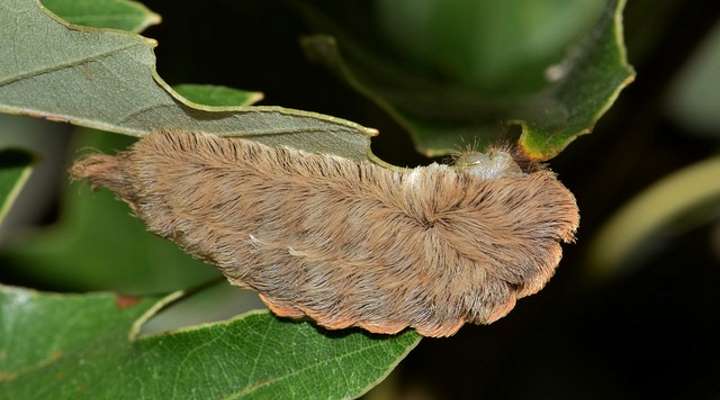
The small Southern flannel moth caterpillar is one of the fluffiest types of furry caterpillars with light brown hairs
The southern flannel moth caterpillar is a furry brown caterpillar covered in sandy-brown hairs. This hairy caterpillar has a deceptive appearance because it looks soft, yet the hairs hide venom-filled spines. The stinging caterpillar measures 1” (25 mm) long and can range in color from golden brown to dark gray.
Due to its soft, luxurious appearance and stinging nature, the southern flannel caterpillar also goes by the names puss moth, Italian asp, fire caterpillar, woolly slug, and asp caterpillar.
Hairy caterpillar identification
The southern flannel moth caterpillar is easy to identify because of its soft, disheveled golden-brown hairs.
- Adult Stage: Southern Flannel Moth
- Host Plants: Various trees and shrubs including oak, hickory, and elm
- Habitat and Distribution: Found in the southern United States, primarily in forests, urban parks, and gardens
- Stinging: It is considered dangerous due to its nasty sting. Symptoms from the sting of the caterpillar can vary in severity and may include headache, nausea, fever, and seizures. In addition, touching them can cause a burning sensation and a rash.
Yellow Woolly Bear Caterpillar (Spilosoma virginica)
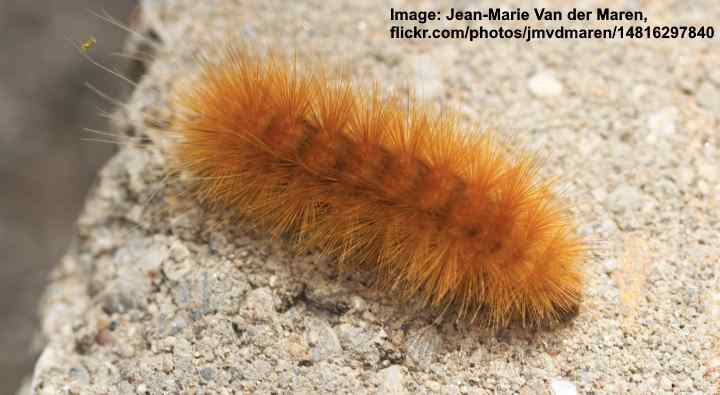
The yellow woolly bear is a common type of hairy caterpillar
The yellow woolly bear caterpillar gets its name from the bronze-brown tufts covering the slug-like creature. The yellowish-brown or golden brown woolly hairs give the caterpillar a soft, fuzzy appearance. Depending on the larva’s habitat, the caterpillar can be black, orangey-red, or dark yellow and grow up to 2” (50 mm) long.
Like most types of hairy caterpillars, the spiny hairs don’t sting or contain venom. However, the hairy tufts can cause local skin irritation when handled without gloves.
Hairy caterpillar identification
The yellow woolly bear caterpillar has tufts of yellow or orangey-brown hairs covering its brownish-tan body.
- Adult Stage: Virginian Tiger Moth
- Host Plants: Various plants including dandelion, nettle, and sunflower
- Habitat and Distribution: Common in North America, particularly in open fields, meadows, and gardens
- Stinging: No significant reports of stinging or causing skin irritation in humans.
Garden Tiger Moth Caterpillar (Arctia caja)
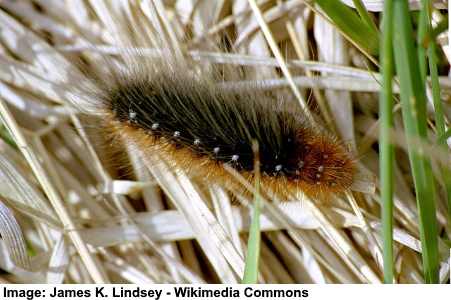
The hairy garden tiger moth caterpillar has black, orange and gray hair-like spines
The garden tiger moth is a large caterpillar covered in black and orangey-brown hairs. Long black and dark gray spines make the caterpillar look like a hedgehog or porcupine. Despite its soft, hairy appearance, the barbed hairs can irritate the skin if you pick up one of these caterpillars.
Garden tiger moth caterpillars are poisonous to predators and birds. These large “woolly bears” turn into a striking moth with black, white, and orange patterns on its wings.
Hairy caterpillar identification
The garden tiger moth is easy to identify with its black and orange hairy body and long grayish spines sticking.
- Adult Stage: The adult stage is the Garden Tiger Moth.
- Host Plants: The caterpillar feeds on various plants, including but not limited to nettles, comfrey, and various low-growing plants.
- Habitat and Distribution: Arctia caja can be found in a variety of habitats such as meadows, gardens, open woodlands, and grasslands across Europe, including countries like the United Kingdom, Germany, France, and others.
- Stinging: The caterpillar of Arctia caja is not typically known to possess stinging hairs or cause significant skin irritation in humans. However, some individuals may experience mild skin irritation upon direct contact.
Walnut Caterpillar (Datana integerrima)
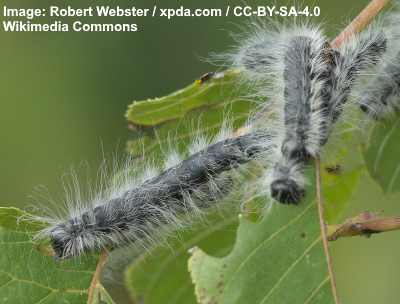
The walnut caterpillar has a black body with white-gray hairs
The walnut caterpillar is a hairy black caterpillar covered in long whitish-gray wispy spines. The crawling caterpillar is harmless to humans, and its spiny covering won’t cause skin irritation if you handle it. The black fuzzy caterpillars are cylindrical and slender and grow around 1.1” (30 mm) long.
An identifying feature of walnut caterpillars is their habit of congregating in large groups. Sometimes the black bugs, with their spindly hairs, can cover branches as they defoliate pecan, butternut, hickory, and walnut trees.
Hairy caterpillar identification
The walnut caterpillar’s identifiable features are its slender, worm-like black body covered in thin hairs giving the caterpillar a fuzzy appearance.
- Adult Stage: The adult stage is the Walnut Caterpillar Moth.
- Host Plants: The caterpillar primarily feeds on various trees, including but not limited to walnut, hickory, pecan, and other hardwood trees.
- Habitat and Distribution: Datana integerrima can be found in woodland areas, parks, gardens, and forests across North America, particularly in the eastern and central regions, including the United States and Canada.
- Stinging: The caterpillar of Datana integerrima is not typically known to possess stinging hairs or cause significant skin irritation in humans. However, direct contact with the caterpillar may cause mild skin irritation in some individuals.
Monkey Slug Caterpillar or Hag Moth (Phobetron pithecium)
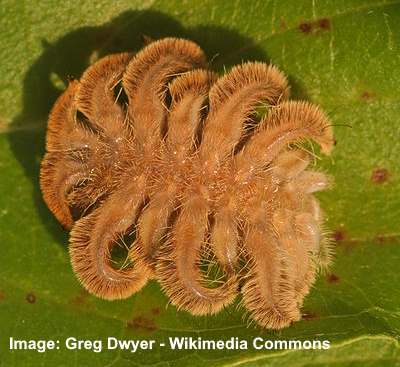
The hairs on the monkey slug caterpillar can cause skin irritation
The monkey slug caterpillar is one of the most unusual hairy caterpillars you’ll find. Also called the hag moth caterpillar, the brown furry larva is unique in the caterpillar world. The golden-brown slug has 18 curled hairy projections along its body, giving it the appearance of a squashed spider.
Monkey slug caterpillars measure 0.6” to 1” (15 – 25 mm) long. The dark tan hairs covering the caterpillar’s body can cause an allergic reaction and severe skin irritation.
Hairy caterpillar identification
The monkey slug caterpillar is easy to identify because there is no caterpillar like it—hairy or otherwise. The shaggy brown caterpillar has nine pairs of curly brush-like protrusions.
- Adult Stage: Monkey Slug Caterpillar transforms into the Hag Moth (Phobetron pithecium)
- Host Plants: The caterpillar feeds on a variety of trees and shrubs including oak, chestnut, dogwood, sassafras and ash
- Habitat and Distribution: Found in gardens, forests, and meadows across North America
- Stinging: Has stinging hairs that can cause skin irritation. In some people, an allergic skin reaction may happen from handling a Monkey slug caterpillar.
Salt Marsh Moth Caterpillar (Estigmene acrea)
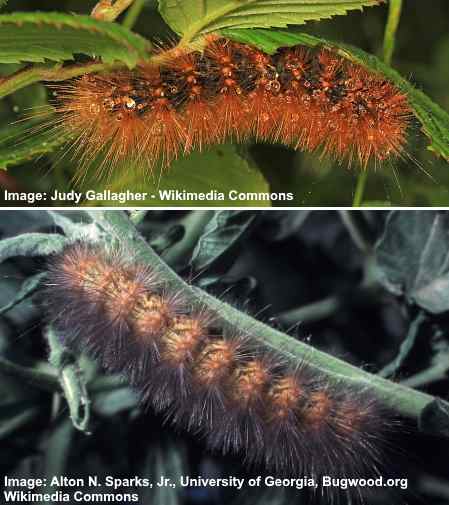
The hairy salt marsh caterpillar can vary in color from tan to dark brown, almost black
The salt marsh caterpillar is a brown hairy moth larva with sharp-looking spines poking out from its body. Although the bristles look sharp, they are soft and won’t sting. However, like many species of hairy caterpillars, the irritating setae can make your skin feel itchy after handling one.
The hairy orange-brown caterpillars have a cylindrical, plump body measuring 2” (50 mm) long. Another characteristic feature of the segmented larva includes a row of orange warts with a white dot.
The dark hairy caterpillars feed on soybean, cabbage, cotton, and tomato plants.
Hairy caterpillar identification
The salt marsh caterpillar is characterized as a slender, dark brown hairy bug with a row of black or orange spots along its abdomen.
- Adult Stage: Salt Marsh Moth
- Host Plants: Grasses, clover, dandelion, sunflower, and other herbaceous plants
- Habitat and Distribution: Salt marshes, meadows, and other open areas in North and South America
- Stinging: The caterpillar of Estigmene acrea is not known to possess stinging hairs or cause significant skin irritation in humans. However, direct contact with the caterpillar may cause mild skin irritation in some individuals.
Hickory Tiger Moth Caterpillar (Lophocampa caryae)
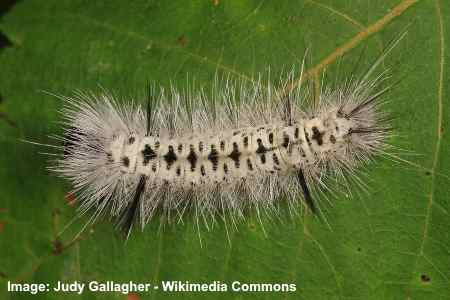
The hairy hickory tussock caterpillar has black patterns along its white back
Also called the hickory tussock moth caterpillar, the hairy white caterpillar is identified by its diamond-shaped black patterns along its back. This furry bug also has tufts of black pencil hairs and a rounded shiny head—typical of many tussock caterpillars. This black and white hairy caterpillar measures 1.7” (45 mm) long.
Hickory tiger moth caterpillars have barbed spines. Despite their soft appearance, the hairs can get lodged in your skin, causing mild to severe irritation. The furry white larvae feed on pecan, walnut, hickory, willow, and other deciduous trees.
Hairy caterpillar identification
The hickory tiger moth is a white caterpillar covered in tufts of white hairs and distinctive black markings on its back.
- Adult Stage: Hickory Tussock Moth
- Host Plants: The fuzzy white and black caterpillar of the hickory tussock moth feeds on a wide array of hardwood trees. They
have a particular fondness for birch, quaking aspen, basswood and black locust - Habitat and Distribution: Common in eastern North America, primarily in deciduous forests and wooded areas
- Stinging: Can cause skin irritation upon contact, with the potential for a rash and allergic reactions
Yellow Spotted Tussock Moth Caterpillar (Lophocampa maculata)
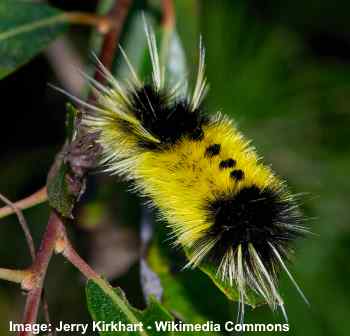
The yellow-spotted tussock caterpillar has a distinctive look with its yellow and black hairs
The hairy yellow-spotted tussock moth is a striking caterpillar due to its bold black and yellow coloring. The yellow caterpillar has jet back ends and long tufts of brilliant white hair pencils. Its dramatic yellow and black colors make the caterpillar easy to spot on shrubs and trees.
Yellow-spotted tussock moth caterpillars also go by the name yellow woolly bear due to the moth’s furry appearance. The hairy yellow and black tussock caterpillar measure up to 1.1” (30 mm) long.
Hairy caterpillar identification
The yellow-spotted tussock moth larva is easy to recognize due to being covered in yellow and black hairs with tufts of white lashes at its head and rear end.
- Adult Stage: The adult stage is the Spotted Tussock Moth.
- Host Plants: The caterpillar feeds on various plants, including but not limited to alder, willow, maple, and other deciduous trees.
- Habitat and Distribution: Lophocampa maculata can be found in diverse habitats such as forests, woodlands, parks, and gardens across North America, particularly in the northern and central regions, including the United States and Canada.
- Stinging: The caterpillar of Lophocampa maculata is not typically known to possess stinging hairs or cause significant skin irritation in humans. However, some individuals may experience mild skin irritation upon direct contact.
Fall Webworm (Hyphantria cunea)
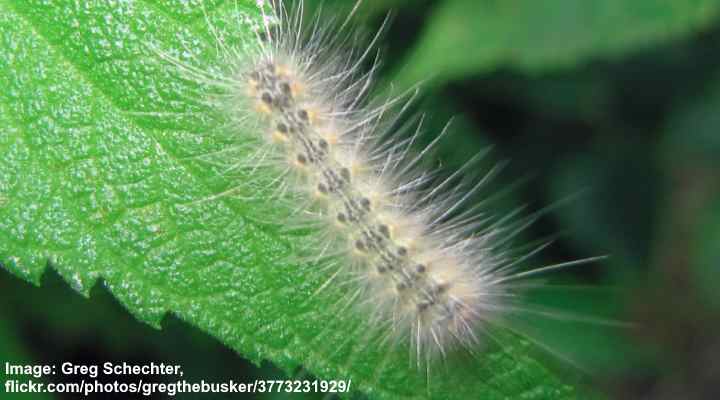
The white hairy fall webworm can cause a lot of damage to shrubs and trees
The fall webworm is a hairy white or pale-yellow caterpillar covered in thin whitish filaments. The characteristic behavior of hairy white fall webworms is to create tent-like structures where hordes of crawling larvae live. You can also recognize fall webworms by their rounded shiny black or red heads.
Fall webworms are easy to spot in their large nests dangling on the ends of trees. The fuzzy white larvae grow up to 1.37” (35 mm) and spend most of their time in the web tents.
After pupating, the slender hairy bugs turn into spectacular white moths.
Hairy caterpillar identification
The identifying features of the fall webworm are the thread-like hairs covering their slender black or dark brown bodies.
- Adult Stage: The adult fall webworm moth is a white moth with small black spots on its wings.
- Caterpillar Feeds on: The caterpillar feeds on the leaves of a wide range of deciduous trees and often creates silken web nests.
- Habitat: These caterpillars can be found in gardens, orchards, and woodlands.
- Stinging: No, they do not have stinging hairs.
Pale Tussock Moth Caterpillar (Calliteara pudibunda)
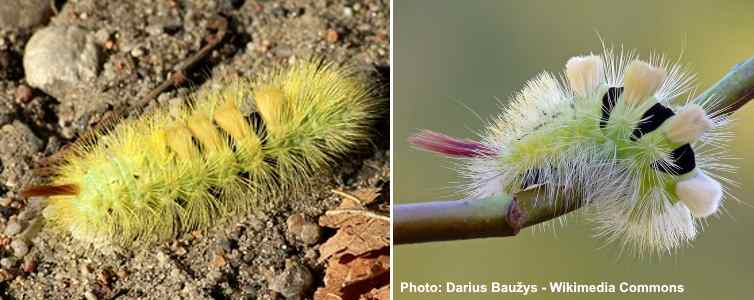
The pale tussock caterpillar has yellow tufts of hairs and black bands on its body
The pale tussock moth caterpillar is a strange-looking hairy caterpillar with a yellowish-green color. As with all tussock caterpillars, the fuzzy larva has characteristic tufts along its back. This yellowish-green caterpillar also has a pronounced reddish tuft of lashes at one end. The caterpillar reveals black stripes when it curls.
The large yellow, pale tussock moth caterpillar measures between 1.5” and 1.7” (40 – 45 mm) long. The hairy caterpillar can be red, pale brown, or green, depending on the instar. However, yellow and green coloring is the most common.
Hairy caterpillar identification
The brightly colored pale tussock moth is identified by its toothbrush tufts of bright yellow setae, black bands, and a protruding tuft of hair pencils at its rear end.
- Adult Stage: The adult stage is the Pale Tussock Moth.
- Host Plants: The caterpillar primarily feeds on various trees, including but not limited to oak, birch, and other deciduous trees.
- Habitat and Distribution: Calliteara pudibunda can be found in diverse habitats such as woodlands, forests, parks, and gardens across Europe, particularly in countries like the United Kingdom, Germany, France, and others.
- Stinging: The caterpillar of Calliteara pudibunda is not known to possess stinging hairs or cause significant skin irritation in humans. However, direct contact with the caterpillar may cause mild skin irritation in some individuals.
Fox Moth Caterpillar (Macrothylacia rubi)

The hairy black fox moth caterpillar has orange marking along its back
The fox moth caterpillar is a black hairy caterpillar with bright orange back and covered in black hairs. The furry black and orange caterpillar measures up to 3” (8 cm) long. The black fox moth caterpillar turns into an attractive tan-colored furry moth that has a large body.
Fox moth caterpillars can be found feeding on small shrubs, flowering perennials, and trees such as birch trees, willows, and plants in the bean family.
Black and Orange Caterpillar Identification
The fox moth caterpillar is identified by its hairy black body and bright orange markings running along its back.
- Adult Stage: Fox Moth
- Host Plants: Feeds on various plants including heather, bilberry, and clover.
- Habitat and Distribution: Found in grasslands, heathlands, and moorlands across Europe and parts of Asia.
- Stinging: The Fox Moth Caterpillar does not have strong stinging capabilities, although its bristles may cause mild skin irritation in some people..
Virginia Ctenucha (Ctenucha virginica)
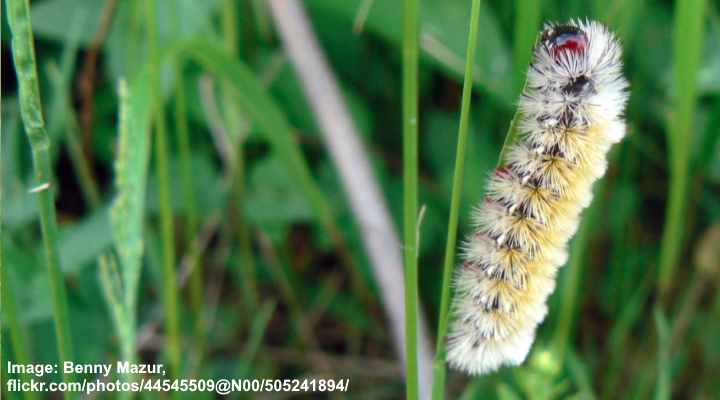
The small Virginia ctenucha caterpillar has white and yellow hairs and red head
The Virginia ctenucha caterpillar is covered in white hairs and yellow tufts, giving the fuzzy larva a creamy white appearance. The hairy, spiky caterpillar also has a red head and crimson red prolegs. The white caterpillar is easy to spot against green foliage.
These tiny hairy caterpillars grow between 0.8” and 1” (20 – 25 mm) long. After pupation, the colorful hairy caterpillar turns into one of the largest wasp moths in North America.
It’s good to remember that in some instars of this species, the caterpillar looks like a hairy black caterpillar with a white stripe along each side.
Hairy caterpillar identification
The Virginia ctenucha caterpillar is easy to identify due to its white and yellow tufts of hair covering its slender body.
- Adult Stage: The adult Virginia ctenucha moth is a black and orange wasp-like moth.
- Caterpillar Feeds on: The caterpillar primarily feeds on various grasses.
- Habitat: These caterpillars are often found in meadows and grassy areas.
- Stinging: No, they do not have stinging hairs.
Related articles:
